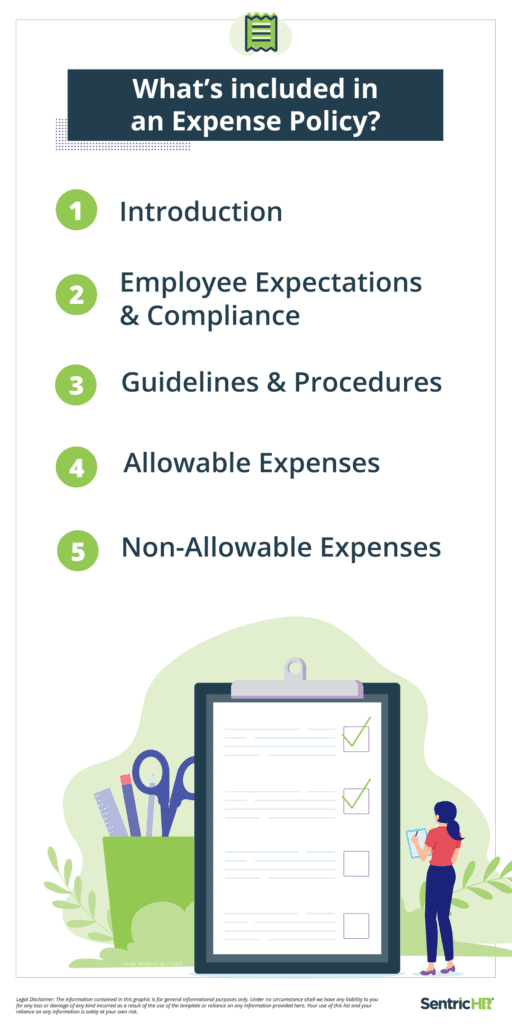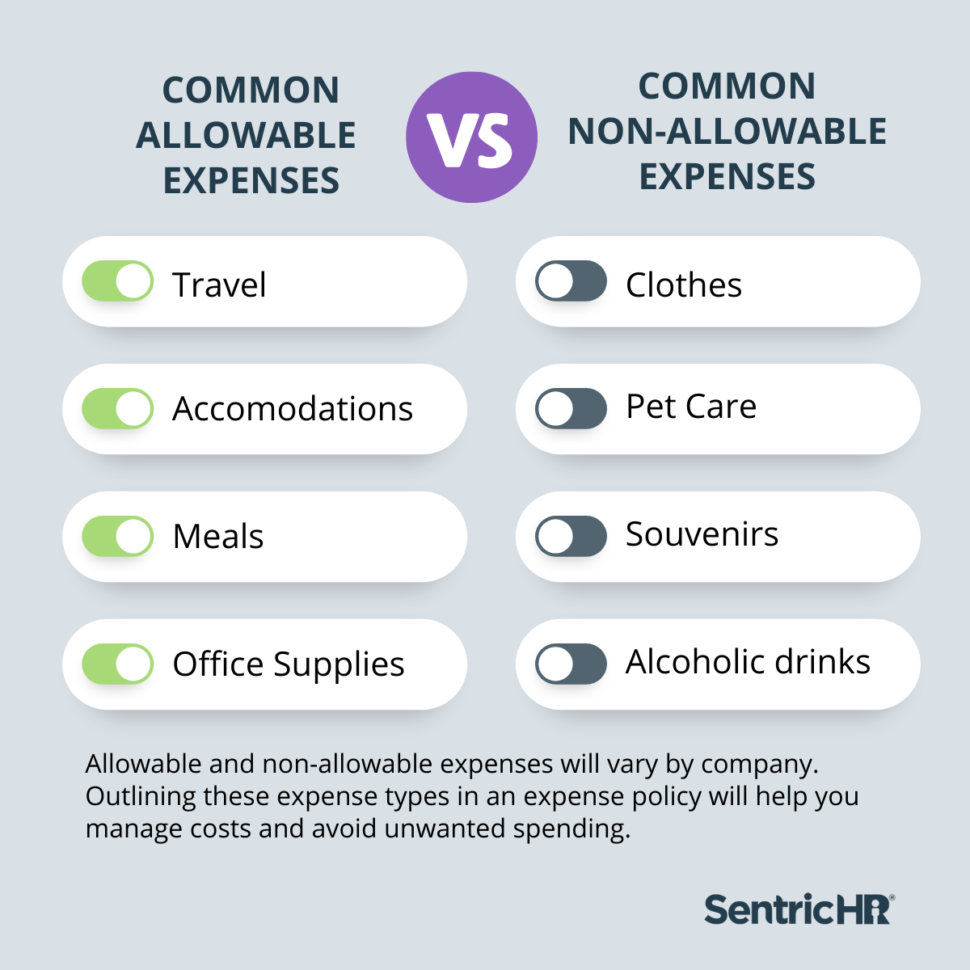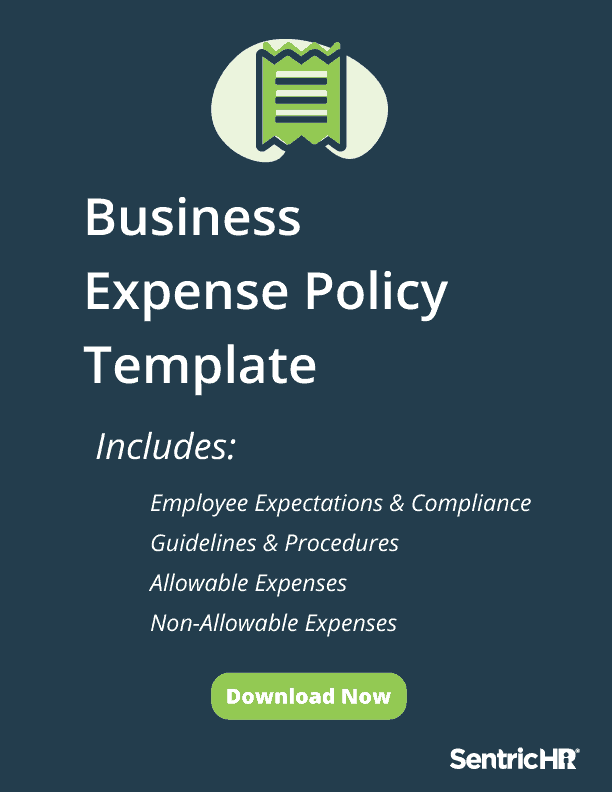Key Points about expense policies:
- Expense policies help you control business costs by setting guidelines for employee spend.
- Most policies have sections for travel, accommodation, meals, and other business expenses.
- If you want to create your first expense policy (or revamp an existing one), check out our free Business Expense Policy template.
What is an Expense Policy?
A company expense policy is a guide for employees who make purchases using company funds. Expense policies outline allowable work-related expenses and purchases, the reimbursement process (including expense reports), and other details to help your business manage spend.
The exact details of your expense policy will differ depending on your business and any state-specific requirements, but most include similar information. We explain these inclusions and general best practices to help you create a policy that works for your business.
Why do I need a business expense policy?
If your employees use company funds to make purchases, an expense policy is crucial to managing employee spending and avoiding unwanted expenses. When employees have clear guidance, they’re less likely to spend company funds on unnecessary or unreasonable items and services.
A successful expense policy also streamlines the submission, approval, and reimbursement processes, making expense management easier for everyone.
What’s included in an expense policy?

Introduction
Begin your expense policy with an introduction that explains the purpose of your policy, who it applies to, and the date it was last updated.
Employee Expectations & Compliance
This section outlines employee expectations and responsibilities. It may also include general rules about your expense policy. Your policy should be able to answer all of these questions:
- What are your general expectations for employees making purchases with company funds (ex. using proper judgement about expenses)?
- If an employee doesn’t comply with your policy, what are the consequences?
- If an employee commits fraud or engages in other illicit behavior, will you take disciplinary action?
Guidelines & Procedures
Next, outline your guidelines and procedures regarding:
- Submitting and tracking expenses
- Pre-approvals
- Approvals
- Reimbursements
- Advances
- Any other processes relevant to your business expenses
Each process should explain the employee’s responsibilities, the documentation required, and the person who approves the request. Your processes should also include deadlines to ensure you receive everything in a timely manner. You should try to get approvals and reimbursements back to employees within a similar time frame.

Allowable Expenses
In this section, list out the expenses your company will reimburse, along with any spend limits. You may also note which expenses require pre-approval. This usually applies to larger purchases.
Most policies break up this section, grouping similar types of expenses together.
Travel
Travel expenses are one of the most common expense categories.
Before you begin, you may want to explain what “travel” means in relation to your policy. For example, you may limit “travel” to overnight trips. Or you may include a short drive to visit clients as “travel.” What you do will depend on your business.
You may also want to keep in mind the various discounts available to your company. For instance, some companies have flat rate agreements with specific car rental agencies and require their employees to book through a certain carrier. Others designate one person to make all travel-related purchases so they can take advantage of credit card and other reward programs.
Once you have this information down, state the travel expenses that your policy will cover. Most policies address:
- Airfare
- Train fare
- Taxi, Uber, Lyft, etc. fare
- Car rentals
- Mileage
You may also include indirect travel-related expenses in this section. These expenses can include:
- Parking
- Baggage
- Visa or passport fees
- Foreign currency exchange fees
- Foreign transaction fees for credit or debit cards
- Cell phone or SIM card fees
- Travel insurance
Accommodation
This section includes guidelines for overnight lodging. For example, you may ask your employees to book accommodation through a specific travel website or agency.
You may also set a reasonable price range for lodging so employees know they can’t book a 5-star hotel. Remember to consider the rate differences between hotels inside and outside city limits.
Meals
Most businesses give traveling employees a per-day or per-meal budget for food.
You might, for example, give employees $50 per day for meals. They will need to budget accordingly, and if they exceed $50 per day, they will need to cover the excess themselves.
Miscellaneous
Some expenses may not be covered by the categories above. In that case, you can make a miscellaneous section. Examples of miscellaneous expenses may include:
- Office supplies
- Postage
- Medical expenses
- Training or exam fees
Non-Allowable Expenses
This section details the expenses that your business will not reimburse. What you list here will depend on your business, but some to consider include:
- Clothes
- Pet care
- Souvenirs or personal gifts
- Alcoholic drinks or mini-bar purchases
- Visits to tourist attractions
- Fees (parking tickets, traffic violations, airline memberships, etc.)
- Personal entertainment (movies, books, etc.)
Expense Policy Best Practices
The best expense management policies follow three main guidelines:
- Simplicity
When it comes to expense policies, simple is best. Your policy is a set of guidelines. It doesn’t need to cover every single scenario. Your employees also need to understand it, so keeping everything straightforward will help.
- Flexibility
Your expense policy is not set in stone – nor should it be. Keeping it flexible allows you to account for any changes or unforeseen circumstances. This also makes it easier to update it to stay compliant with company changes and any new legislation.
- Fairness
Lastly, your policy should be fair. Apply the same guidelines to everyone at your company so no one gets special treatment.
Your allowable expenses and limits should also be realistic. If they aren’t close to the average costs employees incur, you may put unnecessary strain on your employees. They shouldn’t have to spend hours looking for the cheapest travel option or stay in an unsafe location just to remain within budget.
Once you’ve created your expense policy, be sure to share it with your employees.
Automate Business Expense Tracking
After you’ve created your expense policy, your next challenge will be tracking all of your expenses. This is where expense management software can step in and relieve some of your burden.
Expense management software automates processes based on the rules in your policy. This saves you time and gets approvals and reimbursements to your employees faster.
SentricHR’s all-in-one solution combines HR, payroll, benefits, and expense management, giving you the ability to manage every process in one place.
Use an expense policy template
Whether you’re creating your first business expense management policy or adjusting an existing one, our template can help you get started. Download our free Business Expense Policy template now to control costs and manage expenses more effectively.









